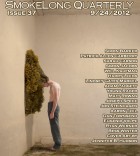First I want to say “Quantifiable Consequence” has an amazing structure. The structure is balanced, words are given to the narrator’s interactions with both parents, as well as the result of his interactions with the children he tries to entertain but disillusions instead. Sometimes writers claim that creating structure happens intuitively and others say that once they have a story they go back in to bring order to it. So to my question, how did you achieve this?
When I wrote this story, I wanted to capture the process a person’s brain undergoes when a particular event significantly shakes up their life. I think when people try to deal with these kinds of shake-ups, they tend to reflect in a very chaotic way. The brain decides all on its own which events of our lives to recall and reexamine, and those particular memories (often memories we’ve thought we’ve long buried) suddenly hold much more weight to them. Much more resonance and meaning. So as I began to draft the story, I knew the chronology would have to be mixed up, and I wanted the narrator’s chaotic reflection to show a logical process of how his perception of his family has changed and hopefully finds meaning in that process.
You certainly achieved that goal. The other thing that struck me was that he was smoking with his dad and drinking with his mother, two things that can create chaos in families. And at twenty-one, he becomes a clown. This job suggests at that point in his life, he was optimistic, having fun. The contrast of the last segment to what we already understand about his parents carries an impact. Many writers struggle with this kind of sequencing of story. What advice would you give someone who doesn’t quite understand the importance of structure?
I wrote one story several years ago (a much longer one) where I mixed up the chronology. But the story didn’t work because I used the chronology as a gimmick as opposed to using it with a specific rhetorical purpose. Whenever we write stories, we are constantly making choices, and the structure tends to be the first major choice. Past or present. First or third limited (or even
second-person). To use flashbacks or not. How many and how often. I’m not a huge fan of experimental fiction. I like precision, clarity, and specificity. Our rhetorical choices should have specific reasons for the specific story, and if these reasons are absent, those choices may become a gimmick as opposed to a storytelling device.
Can you talk a little about why you write? Is this something you’ve always done or is it something that grew over time? What compels you?
That’s a good question. I don’t really understand what compels me to do half the things I do. I used to read a lot as a kid. It was sort of my tool for shutting things out. I’ve always written, but I didn’t take my fiction seriously until about six years ago. It’s an interesting thing that happens when you start to take your writing seriously. You write because you think you have something important to tell the world, and then you write because of the challenge of the process—the puzzle-like nature of it—and then, when the world sends you that millionth rejection letter, you don’t exactly know why you continue to write. You lose exactly what compels you, but you know that if you don’t, that idea nagging at your brain isn’t going to go away until you get the words down. And so, I write.
You’ve always been a reader. What books and/or authors impressed you when you were younger? Who or what impresses you now?
I wish I could say that I read Crime and Punishment or Ulysses when I was twelve, but I was firmly planted in young adult fiction. I read R.L. Stine and comic books (especially Spider-Man) like they were going out of style. As an adult, I find myself a constant student of McCarthy, O’Connor, and Hemingway. As a North Carolinian myself, Ron Rash is huge for me. He is, in my opinion, the very best writer coming out of NC today. Dennis Johnson, Tom Franklin, and Brad Watson are a few others. Dan Chaon’s Await Your Reply was the last new novel I read that really blew me away.
What do you take from these authors? What do they teach you about writing?
There’s something about Southern fiction that I can’t get away from. In Southern fiction, the conflicts are dirtier. They are not generally stories of middle-class moroseness or writers writing stories about writers. They are stories of consequence. Stories that uncover some universal truth about human nature through violence and the grotesque. Stories about morality verses traditional values (as in O’Connor’s “Christ-haunted south”). They should, as McCarthy says, deal in some way with issues of life and death. I’ve learned to ask myself, how might a particular conflict crush or liberate a character’s life? Are the consequences heavy enough? Revealing enough?
I want to know who you plan to “crush or liberate” in the future. What’s on tap for you, a collection, a novel, a screenplay? We want to know so we can get in line to read it.
Well, I’m working on a short story collection that I always think is almost finished until I decide to take a story out and put a new one in. I’ve started the first pages of a novel, but am still trying to decide if it’s something I can commit to. I’ve always had trouble committing to big projects, but I just might stick with this one.



 The core workshop of SmokeLong Fitness is all in writing, so you can take part from anywhere at anytime. We are excited about creating a supportive, consistent and structured environment for flash writers to work on their craft in a community. We are thrilled and proud to say that our workshop participants have won, placed, or been listed in every major flash competition. Community works.
The core workshop of SmokeLong Fitness is all in writing, so you can take part from anywhere at anytime. We are excited about creating a supportive, consistent and structured environment for flash writers to work on their craft in a community. We are thrilled and proud to say that our workshop participants have won, placed, or been listed in every major flash competition. Community works.